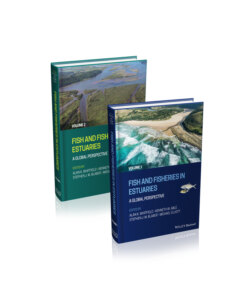Читать книгу Fish and Fisheries in Estuaries - Группа авторов - Страница 85
3.6.2 Sciaenidae
ОглавлениеFishes in the family Sciaenidae are common estuarine species of tropical and temperate regions. Many share a common reproductive strategy defined by offshore spawning, larval dispersal to estuaries and recruitment of postflexion larvae or juveniles to estuarine nurseries (Able & Fahay 2010). Sciaenid larvae provide some of the best examples of depth‐regulated and tidally mediated behaviours that support ingress into estuaries and retention of pre‐settlement stages. Research on ichthyoplankton in western Atlantic and Gulf of Mexico coastal waters of the USA has provided a reasonably good understanding of dispersal processes. Newly hatched larvae are broadly distributed in shallow coastal waters, indicating widespread spawning (Cowan & Shaw 1988, Shaw et al. 1988, Norcross 1991, Reiss & McConaugha 1999, Schaffler et al. 2009). For example, in the shallow shelf waters of the Gulf of Mexico, spawning by sciaenid fishes occurs from a few kilometres to >100 km offshore (Cowan & Shaw 1988).
Shelf processes that disperse sciaenid larvae indicate that residual onshore currents, favourable winds and, for some species, vertical migratory behaviour or depth selection by larvae are involved in the transport dynamics from offshore to the coast (Cowan & Shaw 1988, Hare et al. 1999, Hare & Govoni 2005). Norcross (1991) found that most Micropogonias undulatus larvae collected offshore (5–25 km) from Chesapeake Bay were at mid‐depth or near bottom in a stratified water column of ~20 m depth but were homogeneously distributed when waters were not stratified. The author believed that larvae were well positioned to enter the Bay through wind‐driven or passive entry in bottom flow. Schaffler et al. (2009) reported that M. undulatus larvae generally were located deep in the water column in offshore, nearshore and estuary‐mouth collections near Chesapeake Bay, potentially facilitating onshore transport and ingress to the Bay.
In the northern Gulf of Mexico, larvae of several sciaenid species experience slow onshore (northerly) transport, followed by rapid lateral transport to the west–northwest in a westward‐flowing, coastal boundary current that delivers larvae to estuaries in Texas, far west of the offshore spawning areas sampled by Cowan & Shaw (1988). Transit times for sciaenid larvae to reach estuaries from offshore sites range from 50 to 90 days (Cowan & Shaw 1988, Shaw et al. 1988). A numerical model (Brown et al. 2004) indicated that larvae of Sciaenops ocellatus were transported to a Texas estuary in a coastal boundary current, as hypothesised by Cowan & Shaw (1988). Sciaenid larvae may also have a swimming capability sufficient to gain ingress to estuaries from nearshore coastal waters. For example, postflexion larvae of S. ocellatus can swim at velocities, and with endurance, sufficient to direct their transport (Faria et al. 2009).
There is extensive knowledge on ages and stages of ingress by sciaenid larvae on the Atlantic and Gulf coasts of the USA, e.g. Sciaenops ocellatus, Leiostomus xanthurus, Micropogonias undulatus. At ingress, larvae appear to use STST or at least remain at moderate to deep depths in the water column, to facilitate ingress in near‐bottom inflows at estuary mouths (Holt et al. 1989, Norcross 1991, Govoni & Pietrafesa 1994, Forward et al. 1999, Reiss & McConaugha 1999, Schieler et al. 2014, Hale & Targett 2018). A high proportion of larvae of M. undulatus at the mouth of Chesapeake Bay remains below the surface mixed layer in the classic two‐layer flow near the mouth (Norcross 1991), favouring ingress of larvae. As noted by Norcross (1991), not all larvae need to remain consistently in the bottom layer to assure successful ingress and recruitment. Additionally, Hare et al. (2005a) reported tidally driven vertical migrations by M. undulatus at the Chesapeake Bay mouth and calculated a substantial up‐estuary larval flux.
Sciaenops ocellatus provides a good example in which mortality rates and back‐calculated growth rates were analysed to evaluate early‐life processes affecting recruitment. A seasonal pattern of growth and mortality rates of larvae indicated highest growth and lowest mortality during fall months under falling temperatures in the Aransas Estuary (Texas, USA) (Rooker et al. 1997, 1999). Research on larvae and newly settled juveniles indicated that mean rates of weight‐specific growth (about 5% d−1) and mortality (about 13% d−1) were similar in two years. In a two‐decade analysis of age‐0+ juveniles of S. ocellatus in Texas estuaries, Scharf (2000) reported substantial spatial variability in growth and mortality rates amongst estuaries. Results supported the probability that juvenile mortality and growth processes play a significant role in regulating recruitment and year‐class sizes of S. ocellatus. Abundances of juveniles amongst Texas estuaries were positively correlated, indicating that offshore abundances of eggs and larvae in each year, and hydrodynamic processes that disperse larvae to estuaries, set the stage for subsequent estuarine processes in which local environmental and habitat variables governed growth and mortality of settled juveniles. Additionally, there was weak evidence for density‐dependent mortality in S. ocellatus juveniles that could regulate recruitment (Scharf 2000).
